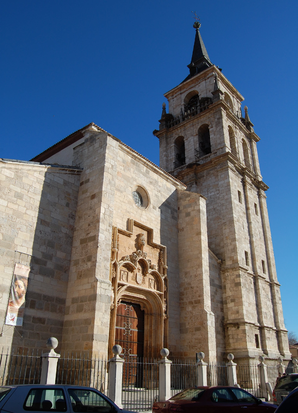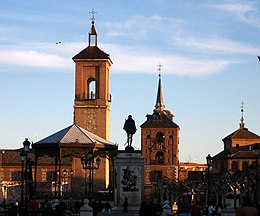Alcalá de Henares
| Alcalá de Henares municipality | ||
|---|---|---|

|
||
| coat of arms | Map of Spain | |

|
|
|
| Basic data | ||
| Autonomous Community : |
|
|
| Province : | Madrid | |
| Comarca : | Metropolitana de Madrid | |
| Coordinates | 40 ° 29 ′ N , 3 ° 22 ′ W | |
| Height : | 654 msnm | |
| Area : | 87.7 km² | |
| Residents : | 195,649 (Jan 1, 2019) | |
| Population density : | 2,230.89 inhabitants / km² | |
| Postal code : | 28801-28807 | |
| Municipality number ( INE ): | 28005 | |
| Nearest airport : | Madrid-Torrejón Airport | |
| administration | ||
| Official language : | Castilian | |
| Mayor : | Manuel Peinado Lorca ( PSOE ) | |
| Website : | www.ayto-alcaladehenares.es | |
Alcalá de Henares is a city in the Comunidad de Madrid ( Spain ). It was called Complutum in Roman times . The historic Alcalá University, founded in 1499 and one of the most important universities in Europe, was relocated to Madrid in 1836. The buildings of this university and the historic center of the city of Alcalá de Henares were added to the UNESCO World Heritage List in 1998. The name of the city is derived from Arabic ( Arabic القلعة, DMG al-Qalʿa , the castle, fortress') and Henares , the river flowing through the city. The city has 195,649 inhabitants (as of January 1, 2019) and is located on the eastern edge of the Madrid agglomeration ( Área Metropolitana de Madrid with 5.4 million inhabitants). It has been the seat of a Roman Catholic bishop since 1991 .
The inhabitants of Alcalá call themselves Alcalaínos or, after "Complutum" the name the city had in Roman times, Complutenses .
history
In the first century AD, the Romans founded a settlement in the Henares valley , which they named Complutum. The city flourished because it was an important waypoint on the road between Mérida and Saragossa , and had a population of over 10,000. During the conquest by the Moorish Berber peoples in 711, the now Christian city was not captured. A fortress built by Muslims was built on the other side of the Henares, which existed for more than 400 years in a relatively peaceful neighborhood with the settlement inhabited by Christians. In 1118 the Archbishop of Toledo Bernardo de Sedirac conquered the Muslim settlement. Alcalá received city rights in 1184. A large Jewish community developed. In the middle of the 15th century there were over a hundred families.
In 1499, Francisco Jiménez de Cisneros , the Archbishop of Toledo, to whose diocese the city of Alcalá de Henares belonged at that time, founded a university there. Together with the building of the Colegio Mayor, Cisneros had twelve Colegios Menores built from 1499. The Colegios were the part of the university where the students who attended the lectures of the various chairs lived and studied. Further colegios under the patronage of kings and various nobles were added. The monastic orders established monasteries in Alcalá de Henares, which trained members of the order in close cooperation with the university. In this way, a university town emerged within and next to the medieval city during the Renaissance.
As part of the disamortization in Spain in 1835, the monasteries and colegios in Alcalá de Henares were dissolved and the buildings transferred to state ownership and sold. Part of the university's facilities and administration were moved to Madrid in 1836. The Complutense University of Madrid ( Complutense derived from the Latin name Alcalás) has seen itself as the historical successor to the "old" University of Alcalá de Henares since 1970.
As part of the administrative reform of 1821, neighboring Guadalajara was designated the provincial capital. Alcalá de Henares thus became a rather insignificant market town between the capital and Zaragoza. The city lost half of its population.
During the Spanish Civil War , POUM leader Andreu Nin was deported to Alcalá de Henares and tortured by NKVD agents between June 18 and 21, 1937. Significant population growth only began with the rise of the greater Madrid area and the end of the Franco dictatorship .
In 1977 a new Universidad de Alcalá de Henares was founded, which was completely independent from 1978. In 2014 the new university used fifteen of the buildings that were built between 1499 and 1836 for the old university.
Miguel de Cervantes
On October 9, 1547 the writer Miguel de Cervantes Saavedra was baptized in the parish church of Santa María la Mayor in Alcalá de Henares. It is believed that he was born in this city on September 29, 1547. Between 1608 and 1615 he occasionally stayed briefly in Alcalá de Henares. In the house where he was born and in the church where he was baptized, exhibitions commemorate Miguel de Cervantes.
The Premio Miguel de Cervantes is considered the most important literary prize in the Spanish-speaking world. Since 1977, the King of Spain has presented this prize to the winner every year on April 23 in the ballroom of the Colegio Mayor San Ildefonso.
Population development
traffic
Alcalá is connected to Madrid , 28 km away , by a suburban train line ( Cercanías C-1, C-2, C-7) that was the scene of the devastating Madrid train attacks on March 11, 2004 . The 13 bombs were probably placed on the trains at Alcalá station.
Alternatively, there are bus routes that connect Alcalá with Madrid. Intercity buses in Madrid all depart from the underground and bus stations on Avenida de América. They have the numbers 223 (Alcalá), 227 (Universidad) and 229 (V. (irgen) del Val). It is also possible to come from Madrid to Alcalá and back at night. There is a special night line (N202) with the same stops as line 223, which also goes through Torrejón de Ardoz.
Twin cities
Alcalá has nine twin cities :
| city | country | since |
|---|---|---|
| Alajuela |
|
2011 |
| Alba Iulia |
|
2005 |
| Azul |
|
2011 |
| Fort Collins |
|
1995 |
| Guanajuato |
|
|
| Lublin |
|
2001 |
| Peterborough |
|
1986 |
| San Diego |
|
1982 |
| Talence |
|
1985 |
Instituto Cervantes Además, cuenta con dos sedes en España, la sede central de Madrid y la sede de Alcalá de Henares. Inaugurated in 1997 by the Instituto Cervantes, the Centro Virtual Cervantes is dedicated to the Spanish language and Spanish-speaking culture.
Attractions
The house where the poet Miguel de Cervantes was born is one of the city's great attractions. Other sights are the many religious buildings, especially the cathedral in the Plaza de los Santos Niños, as well as other churches, chapels, monasteries, etc. For a long time the barracks of the parachute jumpers' brigade were housed in many historical buildings. Today these buildings are or are being renovated for the faculties of the university. Many storks nest on the city's towers and have stayed in Alcalá all year round for several years.
- Main building of the university ( Plateresque style )
- Birthplace of Miguel de Cervantes
- Cathedral (La Magistral at Plaza de los Santos Niños)
- Corral de Comedias (Plaza Cervantes, old theater building)
- Teatro Salón Cervantes
- Palacio Arzobispal (Archbishop's Palace)
- Calle Mayor (between Plaza Cervantes and Plaza Santos Niños, with arcades to protect against heat and rain)
- Botanical garden (new university area)
- Arboretum (in the western part of the city)
- Parque O'Donnell
- Puerta de Madrid (city gate)
- old citywall
- Archaeological finds
- La Cupula Restaurante (restaurant in a former monastery)
- A large number of smaller churches, monasteries, etc.
sons and daughters of the town
- Juan Ruiz (around 1283 – around 1350), Spanish poet
- Catherine of Aragón (1485–1536), first wife of Henry VIII, Queen of England
- Ferdinand I (1503–1564), Emperor of the Holy Roman Empire and King of Bohemia and Hungary
- Miguel de Cervantes (unsecured; 1547–1616), Spanish writer
- Manuel Azaña y Díaz (1880–1940), Spanish politician and writer, Minister of War, President of the Government and President of the 2nd Spanish Republic.
- Demetrio Lozano (* 1975), Spanish handball player
- Daniel Diges (* 1981), Spanish actor and singer
literature
- Sebastián Rascón Marqués, Ana Lucía Sánchez Montes: Complutum, la Ciudad de las Ninfas . In: Civilización: un viaje a las ciudades de la España antigua . 2006, ISBN 84-87914-78-0 , pp. 59–76 (Spanish, [3] [PDF; accessed March 16, 2020]).
- Travel Guide. Alcalá, a unique experience. Ayuntamiento de Alcala de Henares; 2015.
- Javier Rivera Blanco et al .: Universidad de Alcalá. Patrimonio de la Humanidad - World Heritage . Ed .: Universidad de Alcalá. 3. Edition. Universidad de Alcalá, Madrid 2014, ISBN 978-84-16599-76-9 (Spanish, English, [4] [PDF; accessed March 16, 2020]).
Web links
- Municipal website ( Memento from March 20, 2011 in the Internet Archive ) (English)
- Homepage of the University of Alcalá
- Museo Casa Natal de Cervantes at Google Cultural Institute
- A comprehensive list of places of interest ( Memento of November 13, 2006 in the Internet Archive ) (Spanish)
Individual evidence
- ↑ Cifras oficiales de población resultantes de la revisión del Padrón municipal a 1 de enero . Population statistics from the Instituto Nacional de Estadística (population update).
- ↑ Vicente Fernández Fernández and Ángel Pérez López: Alcalá De Henares - Guía Histórico-Artística. 2009, p. 6.
- ↑ UNESCO World Heritage Center: University and Historic Precinct of Alcalá de Henares. UNESCO, 2020, accessed March 1, 2020 .
- ↑ Ajuntamiento de Alcalá de Henares accessed on March 4, 2012 (Spanish)
- ↑ Ajuntamiento de Alcalá de Henares accessed on March 4, 2012 (Spanish)
- ^ Antony Beevor, The Spanish Civil War, ISBN 978-3-442-15492-0 , 2nd edition, page 348
- ↑ Javier Rivera Blanco et al .: Universidad de Alcalá. Patrimonio de la Humanidad - World Heritage . Ed .: Universidad de Alcalá. 3. Edition. Universidad de Alcalá, Madrid 2014, ISBN 978-84-16599-76-9 , pp. 75 (Spanish, English, [1] [PDF; accessed on March 16, 2020]).
- ^ Jean Canavaggio: Cervantes en su vivir . Biblioteca Virtual Miguel de Cervantes, Alicante 2004 (Spanish, [2] [accessed March 16, 2020]).
- ↑ a b c d e San Diego International Sister Cities Association . Archived from the original on November 6, 2014. Retrieved January 9, 2020.
- ↑ Alcalá de Henares y Azul, "Ciudad Cervantina de Argentina" firman mañana su hermanamiento . Retrieved November 6, 2014.
- ↑ Miasta partnerskie Lublina . Archived from the original on November 6, 2014. Retrieved November 6, 2014. ( Polish )
- ↑ Alcalá de Henares . Archived from the original on November 7, 2014. Retrieved January 9, 2020. ( English )





